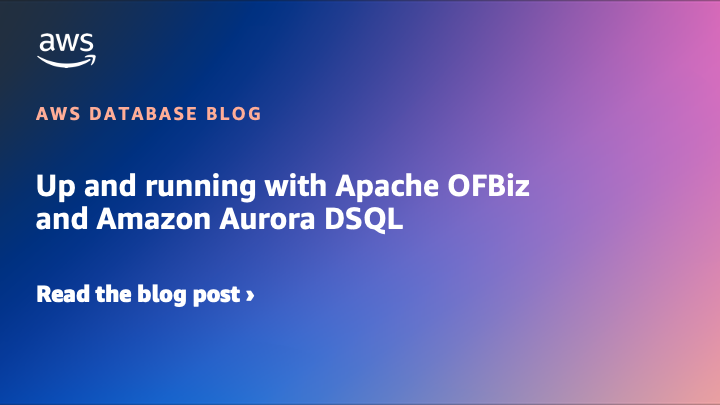AWS Database Blog
Category: Learning Levels
Up and running with Apache OFBiz and Amazon Aurora DSQL
In this post, we show you a worked example of taking an existing application that works on PostgreSQL databases and adapting it to work with an Aurora DSQL database. In addition to adapting for the previously mentioned aspects, we also address some data type incompatibilities and work around some limits that currently exist in Aurora DSQL.
Transition a pivot query that includes dynamic columns from SQL Server to PostgreSQL
When assisting customers with migrating their workloads from SQL Server to PostgreSQL, we often encounter a scenario where the PIVOT function is used extensively for generating dynamic reports. In this post, we show you how to use the crosstab function, provided by PostgreSQL’s tablefunc extension, to implement functionality similar to SQL Server’s PIVOT function, offering greater flexibility.
Integrate natural language processing and generative AI with relational databases
In this post, we present an approach to using natural language processing (NLP) to query an Amazon Aurora PostgreSQL-Compatible Edition database. The solution presented in this post assumes that an organization has an Aurora PostgreSQL database. We create a web application framework using Flask for the user to interact with the database. JavaScript and Python code act as the interface between the web framework, Amazon Bedrock, and the database.
Scheduled scaling of Amazon Aurora Serverless with Amazon EventBridge Scheduler
In this post, we demonstrate how you can implement scheduled scaling for Aurora Serverless using Amazon EventBridge Scheduler. By proactively adjusting minimum Aurora Capacity Units (ACUs), you can achieve faster scaling rates during peak periods while maintaining cost efficiency during low-demand times.
Improve cost visibility of an Amazon RDS multi-tenant instance with Performance Insights and Amazon Athena
In this post we introduce a solution that addresses a common challenge faced by many customers: managing costs in multi-tenant applications, particularly for shared databases in Amazon Relational Database Service (Amazon RDS) and Amazon Aurora. This solution uses Amazon RDS Performance Insights and AWS Cost and Usage Reports (CUR) to addresses this challenge. This allows for efficient grouping of tenants within the same RDS or Aurora instances, while helping you implement accurate chargeback models, optimize resource-intensive workloads, and make data-driven decisions for capacity planning.
Use pgactive for rolling major version upgrades in Amazon RDS for PostgreSQL
In this post, we explore how pgactive can perform rolling major version upgrades for Amazon Relational Database Service (Amazon RDS) for PostgreSQL, allowing for a smoother transition with reduced impact on your applications.
Grouping database tables in AWS DMS tasks for Oracle source engine
AWS Database Migration Service is a cloud service designed to simplify the process of migrating and replicating databases, data warehouses and other data stores. It offers a comprehensive solution for both homogeneous and heterogeneous database migrations, facilitating transitions between different database platforms. The migration process typically involves two major phases: Migration of existing data (full […]
Amazon DocumentDB Quick Start: Zero Setup with AWS CloudShell
Amazon DocumentDB (with MongoDB compatibility) launched its integration with AWS CloudShell. With this integration, you can now connect to Amazon DocumentDB with a single click on the AWS Management Console without needing to perform any setup. In this post, we show how to connect to and work with Amazon DocumentDB using CloudShell. Amazon DocumentDB is […]
Multiple database support on Amazon RDS for Db2 DB instance
Many organizations run IBM Db2 databases across multiple physical servers or virtual machines. This approach leads to resource investments in infrastructure, management, and licensing. Additionally, advancements in hardware technology, increased CPU capacities, and database engine enhancements result in underutilized servers if not rightsized at the outset. To optimize resource utilization, organizations can explore the following […]
Build resilient Oracle Database workloads on Amazon EC2
In this post, we dive into the various architecture patterns and options available for both compute and storage layers while configuring your self-managed Oracle databases on Amazon EC2 to comply with your HA and DR requirements.









